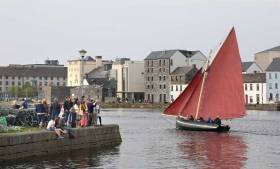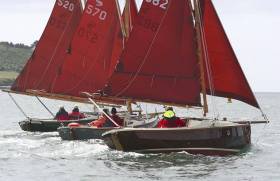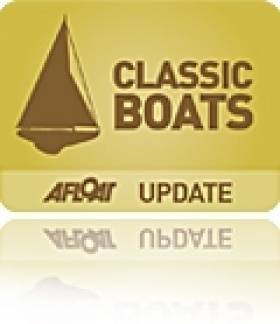Displaying items by tag: Galway Hookers
Conditions Promising for Féile An Spidéil This Weekend
Gentle to moderate south-westerly winds are forecast for this weekend’s Feile an Spidéil.
Many currachs crews and a fleet of Galway hookers will take to the water off An Spidéil, Co Galway, with conditions particularly suitable for the hooker fleet.
There is particular excitement as last year’s event had to be cancelled after several postponements due to weather.
Currach rowing teams from Kerry, Clare and Donegal will join crews from across Connemara and Galway City.
As Aflaot reported previously, racing will take place across six categories from 12 noon on Sunday, weather permitting.
The first race is the senior men’s, which will be followed by the senior women’s contest, with three oarspeople in each craft from several clubs.
Under-18s will have their opportunity to compete, and mixed crew will then compete against each other.
The final racing involves naomhógs in the Craobh na hÉireann event.
The contest between Galway hookers, involving the “ báid mhóra” and “leath bháid” classes, will take place from 3 pm, and there will be music and entertainment onshore for spectators.
A fleet of up to 25 Galway hookers will leave Galway docks on a rising tide today (Sunday, Aug 21) to compete in the Bádóirí an Chladaigh regatta.
Light westerly winds are forecast for Galway Bay, with racing among the smaller vessels – as in gleoiteogs and pucáns – due to start at 12 noon.
The leath-bhád and bád mór class will follow, and spectators should be able to view the fleet from Salthill promenade, according to Peter Connolly of Bádóirí an Chladaigh.

The fleet from the city has been joined by vessels from the county, a number of which were at the Cruinniú na mBád festival in Kinvara, Co Galway last weekend.
Thunderstorms had forced postponement of racing at the Cruinniú on Sunday for the larger vessels, and an initial plan to reconvene on Thursday was also shelved.
Connolly paid tribute to Galway harbourmaster Capt Brian Sheridan for accommodating the visiting traditional craft during the week.
An Mhaighdean Mhara was first boat home in the turf race from Parkmore to Kinvara last Saturday when hundreds of people attended the 43rd annual event.
 An Tonai and crew off Parkmore for the turf race at Cruinniu na mBad Photo: Joe O'Shaughnessy
An Tonai and crew off Parkmore for the turf race at Cruinniu na mBad Photo: Joe O'Shaughnessy
The bád mór was followed by An Tonaí in light winds and an incoming tide, while gleoiteogs competed in the outer bay.
The St Catherine won the gleoteoig class, followed by Naomh Ciarán and An Phantra,
The Naomh Stiofáin won the gleoiteog beaga class, with second place going to the McHugh, according to festival organiser Dr Michael Brogan.
King of the Claddagh Michael Lynskey (88) and his community took to the Galway waterside at the weekend to welcome home a historic workboat which plied the Atlantic during two world wars writes Lorna Siggins
The 8m-long gleoiteog named Lovely Anne has been restored for sail training by Bádoirí an Cladaig.
Some ten nationalities were involved in refurbishing the gleoiteog, built by the well-known boatwright Patrick Brannelly in 1882 when German leader Otto von Bismarck and British prime minister William Gladstone were in power.
Master shipwright Coilín Hernon, who led the restoration with Ciarán Oliver, said Brannelly built a fleet of fine Galway hookers, with just three, including this gleoiteog, An Tonaí and the Morning Star surviving.
Brannelly died in an accident in his early 30s, when the Lovely Anne was being used to transport oysters between Bertraghboy Bay in Connemara and Rosmuc.
It passed through a number of owners in Connemara and on the Aran islands, was restored by Colm Breathnach at Camus, and was then acquired by Jim Parkinson of Killybegs, Co Donegal, who used it to fish salmon.
 The traditional Gleoiteog, the Lovely Anne, was re-launched at the Claddagh in Galway. Pictured on board the 137-year-old boat are Ross Forde, owner of the boat (left), and Pat Brannelly, both decendants of Patrick Brannelly who was the builder of the boat Photo: Joe O'Shaughnessy/Connacht Tribune
The traditional Gleoiteog, the Lovely Anne, was re-launched at the Claddagh in Galway. Pictured on board the 137-year-old boat are Ross Forde, owner of the boat (left), and Pat Brannelly, both decendants of Patrick Brannelly who was the builder of the boat Photo: Joe O'Shaughnessy/Connacht Tribune
Brannelly’s great great grandson, Ross Forde, who is involved with Bádoirí an Cladaig, traced the vessel to Killybegs and persuaded Parkinson to part with it. The refurbishment took five months, with Hernon and two of his sons cutting the sails and equipping the rig.
The Lovely Anne sailed over to Black Weir in Oranmore in the company of Mr Hernon’s gleoiteog, Nora Bheag, before returning to the Claddagh quay for its official welcome.
Mr Forde said that while over in Oranmore, he was told that the vessel had been named after an American woman named Anne, who was given a passage to a small island on it in rough conditions and described it as a “lovely boat”.
Bádoirí an Cladaig has endeavoured to extend its skills to non-sailing / fishing families through courses run with the Galway Roscommon Education and Training Board, and also held its inaugural festival in 2017.
Simon Wood, who had lived in Uganda for many years, and Harald Schlindwein from Germany are among the volunteers recruited by Badóirí an Cladaig, along with Liz Power, who is originally from Galway, and Niamh Moloughney, a Claddagh resident.
“I had been away from Galway for a number of years, and when I returned I wanted to get involved in something a bit bigger than me, “Ms Power explained.
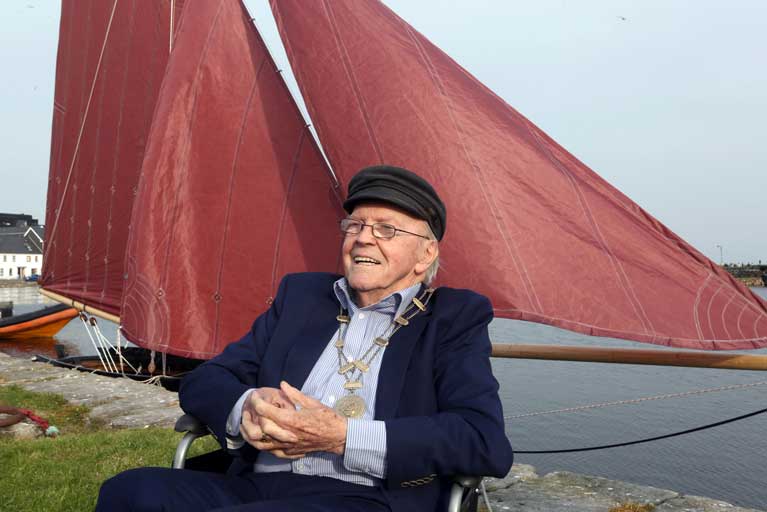 Michael Lynskey, King of the Claddagh, sits at Claddagh Quay during the re-launch of the Geloiteog, the Lovely Anne. Michael was the owner of the Galway Gleoiteog, Annie Photo: Joe O'Shaughnessy/Connacht Tribune
Michael Lynskey, King of the Claddagh, sits at Claddagh Quay during the re-launch of the Geloiteog, the Lovely Anne. Michael was the owner of the Galway Gleoiteog, Annie Photo: Joe O'Shaughnessy/Connacht Tribune
“We did a fair bit of sanding and a fair bit of watching Coilín Hernon doing his expert work,” Ms Moloughney laughed.
Relatives of both the boatbuilder and former owners of the vessel had attended the launch, including Mary Tipton, a relative of Brannelly, who flew from Cornwall, England.
“Not only is this an incredibly moving story of bringing our Galway heritage back to life, but we are extremely delighted to also announce that the Lovely Anne is now our dedicated training vessel,” Ciarán Oliver said. “We will be offering skills training classes for adults and children throughout 2019,” he added.
 Coilin Hernon at the re-launch of the Gleoiteog, the Lovely Anne, at Claddagh Quay in Galway. Coilin was one of the restorers of the 137-year-old boat. He and his sons Coilin Og and Einde also cut the sails for the Lovely Anne Photo: Joe O'Shaughnessy/Connacht Tribune
Coilin Hernon at the re-launch of the Gleoiteog, the Lovely Anne, at Claddagh Quay in Galway. Coilin was one of the restorers of the 137-year-old boat. He and his sons Coilin Og and Einde also cut the sails for the Lovely Anne Photo: Joe O'Shaughnessy/Connacht Tribune
The veteran Volvo Racer Green Dragon (back mast-less in her old home port of Galway since Sunday) has been sorted. Her spare mast will be stepped today, with the port’s adopted French supersailor Yannick Lemonnier playing a key role in getting this nautical heroine of many a campaign back in full seagoing trim.
Meanwhile, the exceptionally summery weather has provided a warm and welcoming mood for the assembly of fourteen-plus Galway Hookers of various sizes for the Claddagh Festival (which continues until Sunday). The two Viking longships from Ardglass have arrived and been put into full warship mode, the highlight of their visit being the Salthill Raid on Saturday, when they’ll be accompanied by the hookers and a fleet of local yachts.
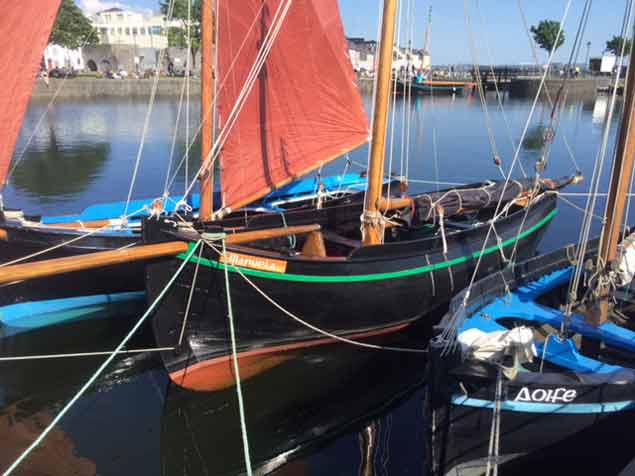 The standard of maintenance in the fleet of traditional craft gathered in Galway this weekend is impressively high. Photo: Pierce Purcell
The standard of maintenance in the fleet of traditional craft gathered in Galway this weekend is impressively high. Photo: Pierce Purcell
Afloat.ie’s man in Galway reports that huge credit is due to anchorman Peter Conneely and his team, led by Colin Hermon, who have put in a massive amount of behind-the-scenes work to bring this very special and successful show together. With the quayside thronged last night with Galway, Connemara, Claddagh and Ardglass folk, the festival mood was running very well.
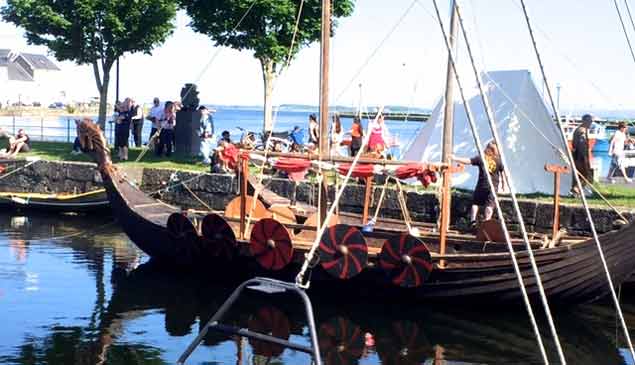 In the summery weather in Galway, the “raiding” Ardglass Viking longships from County Down seem to exude nothing but goodwill Photo: Pierce Purcell
In the summery weather in Galway, the “raiding” Ardglass Viking longships from County Down seem to exude nothing but goodwill Photo: Pierce Purcell
Cornish Shrimpers – Old Gaffer Style With Compact Modern Convenience
With the current prospect of foil-borne IMOCA 60s disappearing towards the horizon at phenomenal speeds in the Vendee Globe Race to remind us of how modern life is just all rush and bustle, we could be forgiven for thinking in terms of getting relaxation afloat with a style of sailing which is about as different as possible writes W M Nixon.
Thus you’d get to thinking in terms of traditional rig and old-fashioned looks in terms of hull shape. But then, it being that time of the year when maintenance planning and its inevitable expenditure is coming top of the agenda, you get to thinking that old-fashioned and winter expense are so often synonymous. So all hail the plastic gaffer. Or more accurately, the new plastic old gaffer.
Both the current and previous International Presidents of the Old Gaffers Association sail the seas in plastic gaffers, and they do such a good job of it that nobody thinks any the less of them for having boats which by-pass the maintenance expense of traditional timber craft. And Denis Aylmer, the top honcho in the Dublin Bay Old Gaffers Association, likewise is plasticized while still gaffing, though it should be remembered that in his much younger days he more than did his duty in preserving Galway hookers which others had thought were beyond saving.
As you get further down this line of sensible traditional-through-plastics line of thought, the logic suggests as small a boat as possible which can properly qualify as an Old Gaffer, yet still be a boat which can be reasonably conveniently road-trailed to your summer’s sailing area.
It might be stretching it a bit to describe the Cornish Shrimper 19 as a trailer-sailer. But as Afloat Boats for Sale currently carries ads for two of these attractive character boats with one in Whitehead in County Antrim and the other in Kilmore Quay in County Wexford, the fact that most Irish sailors would have to think of a journey to get them home adds to their appeal as a very manageable road trail.
As to how you use them, most folk see them as day sailers, but in the Classic version there are two bunks, and the 2 + 2 variant can actually sleep four. That’s thanks to the ingenious incorporation of a V-berth right forward, but frankly you’d need to be very good friends to think of utilising that option.
Cornish Crabbers have been building the Cornish Shrimper 19 since 1979, and more than a thousand now sail the sea. They inspire their own special camaraderie for class rallies and other gatherings. But equally they can give a good showing of themselves in open gaffer events. The one in Whitehead is priced at €12,000, while the one in Kilmore Quay is €15,900 – either way, they’re the perfect antidote if you’re suffering from IMOCA 60 fatigue.
Currachs Race & Yachts Parade into Dublin for River Liffey Spectacle This Weekend
This weekend the River Liffey and surrounding areas come to life in celebration of Dublin’s rich maritime heritage and local boating communities, past and present, with a mix of free open air spectacles and events for the public to enjoy both on the water and on land.
On Friday evening, 18th September, the Dublin Docklands Office and Oireachtas na Gaeilge will stage a Currach racing event on the River Liffey. At 5.30pm on Culture Night, currachs will set off from the pontoon by the Jeanie Johnston Tall Ship and race for 2km up river to the Ha’penny Bridge and back.
On land, a series of talks and films about currachs and the beautiful Galway Hookers will take place in the Dublin Docklands Office on Custom House Quay, while the Dublin Dockers’ Preservation Society will also host an exhibition of photographs chronicling the history and the people of the Docklands.
On Saturday, 19th September, Dublin City Council in conjunction with Dublin Port Company will open three bridges consecutively - the Samuel Beckett, Sean O’Casey and East Link bridges - over the River Liffey to allow the passage of yachts from Dublin Bay to the Custom House Quay area of the city.
The Parade of Sail & River Liffey Cruise event will feature as many as 30 sail boats which will congregate at the East Link Bridge at 3pm on Saturday 19th September 2015. Between 2.30pm and 3.00pm both the Samuel Beckett and Sean O'Casey Bridges will open, followed by the East Link Bridge.
The boats will make their way down the River Liffey through the three bridges and will turn at the Matt Talbot (Custom House) bridge and come back up the river where they will then dock at the pontoons outside the 3 Arena.
A spokesperson for Dublin City Council said: "The Dublin City Council Docklands Office were delighted to be associated with these events which is in keeping with their policy of animating the River Liffey and facilitating its use as a natural resource for the public."
Eamonn O’Reilly, Chief Executive, Dublin Port Company, said: “Dublin Port Company is committed to integrating Dublin Port with the city through a wide range of events and initiatives that celebrate the maritime heritage and traditions of Dublin as a port city. We are delighted to be involved with the Currach racing and Parade of Sail, and I would encourage everyone to come along and show their support for the boating community on the River Liffey this weekend.”
#galwayhooker – Although the classic cutter-rigged Galway hookers are synonymous these days with Connemara and Kinvara, time was when there was a thriving boatbuilding community in the Claddagh in the heart of Galway city. But there hadn't been a substantial traditional boat built there since the 1930s until recently, when shipwright Peter Connolly and the group known as the Claddagh Boatmen began a project to build a 34ft leath bhad in authentic style.
Their evocative and inspiring work has been recorded in meticulous detail by film maker Tony Walsh, and his 86-minute documentary Croi an Claddagh will be making its debut in the New Irish Documentaries section in the 27th annual Galway Film Fleadh, which gets under way in the western capital today.
Croi an Claddagh will be premiered in the Town Hall Theatre in Courthouse Square at 2.15pm this Thursday, July 9th. Meanwhile here's a taster of the kind of work that Tony Walsh has created to record this very special boat-building challenge.
Lecture: “A Hooker Evening with the Men from Kinvarra"
Poolbeg clubhouse overlooks the marina and faces the entrance to Alexandra Basin, where shipping activities of the commercial port can be viewed in closer detail.
To reach the clubhouse which is located on the South Bank, Pigeon House Road, Ringsend, take the Sean Moore Road that connects the Merrion Strand Road (from the south) and the East-Link Toll Bridge (if travelling from the northside).
For further information on the lectures to date click this link and in general about the DBOGA logon here. To contact the PYBC Tel: (01) 668 9983 or logon to www.poolbegmarina.ie/
Badoiri Lurgan

Badoiri Lurgan
Bádoírí Lurgan is a registered non-profit community sailing club organisation. Our proceeds go into insurance, maintaining existing boats, running the community boatclub and mending sails.
The club is based in Spiddal, Co Galway (15 minute drive from Galway), and we have two standing sailing days Wednesday and Sunday, as tides allow, but members can also take out boats on other days if a qualified Skipper is available.
The club also takes part in Regattas over the summer time. The Hooker races form the basis of the cultural and social life in Connemara, the rules are supervised by the Galway Hooker Association. In 2009 we will take part in the Volvo traditional boat regatta on 1st June 2009 in Galway. Some of our club members are professional musicians and we organise events like visiting the Aran islands or a barbeque on the pier.
New members welcome.
We publish an annual Bádoírí Lurgan calendar with beautiful photos of Galway Hookers.
All returns will this year go to new sails for the Muírin.
If you are looking for a calendar please contact us. Calendars can also be sent to continental Europe, US and rest of the world.
Calendar 2010: out for Volvo Ocean Race 2010.
© Text and Photos. Bádoírí Lurgan 2009
Badoiri Lurgan, c/o Jim Horgan, 'Leac Rua', Spiddal, Co. Galway. Tel: 086 1234701, email: [email protected]
Have we got your club details? Click here to get involved


























